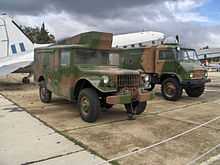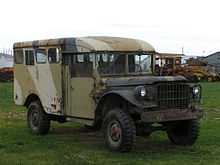Dodge M37
| M37 | |
|---|---|
 | |
| Overview | |
| Manufacturer | Dodge |
| Production | 115,838[1] (1951–1968) |
| Body and chassis | |
| Class | Full-size pickup truck |
| Body style | Truck |
| Layout | Four-wheel drive |
| Powertrain | |
| Engine | Dodge T245 Flathead straight-6 230 CID |
| Transmission | 4-speed New Process NP420 manual |
| Dimensions | |
| Wheelbase |
Cargo M37: 112 in (2.8 m) Command M42: 112 in (2.8 m) Ambulance M43: 126 in (3.2 m) Tele. Maint. V41: 126 in (3.2 m) |
| Curb weight |
M37 without winch: 5,687 lb (2,580 kg) M37 with winch 5,987 lb (2,716 kg) |
| Chronology | |
| Predecessor |
Dodge WC series Dodge WC54[2] |
| Successor | Kaiser Jeep M715 |

The Dodge M37 (G-741) was a three-quarter ton four-wheel drive truck. It superseded the Dodge WC-51, WC-52 and WC-54 trucks in US service and was used extensively by the United States armed forces during the Korean war. A number of variants were produced with slightly different configurations: the M42 command truck, V41 telephone maintenance vehicle, M43 ambulance, M152 enclosed utility truck, and R2 air field fire engine.
Development
The six prototypes of the vehicle were produced in early-to-mid 1950 based on the WC series Dodge vehicles used in World War II, with the first pre-production pilot vehicle rolling off the assembly line on 14 December 1950.[3] Many of the components on the M37 are similar or identical to the World War II vehicle and many deficiencies of the previous series were corrected in the M37. Notably, a conventional pickup truck style bed replaced the platform on the World War II vehicle, simplifying production. The powerplant was identical to the World War II era WC vehicles line, as was most of the drivetrain. The straight-six cylinder engine was derived from a 1930s era passenger vehicle engine that was widely produced. This was in line with a long standing military procurement strategy that attempted to use commercially produced vehicle variants in military service. Many of the accessories on the M37 engine are identical to the engines from that era. There was significant drivetrain and powerplant commonality with the WDX series civilian Power Wagons. Outside of the fenders, there were sheet metal differences between all the vehicles.
Production of the M37 began in earnest in January 1951, with approximately 11,000 vehicles produced by the end of the year. By mid-1954 63,000 of the vehicles had been produced. In 1958 a number of modifications to the design resulted in the new vehicles being designated as M37B1. From mid-1958 until the end of production 47,600 M37B1 vehicles were produced. Approximately 4,500 Canadian M37CDNs were also produced between 1951 and 1955. These vehicles continued in service worldwide in the Israeli and Greek militaries.
In total, between 1951 and 1968, 115,000 M37s were produced. Spare parts for these vehicles are widely available and inexpensive to procure. Many deficiencies with aging design became apparent in the 1960s, including a tendency of the connecting rods to fail at high rpms due to the long cylinder stroke of the engine. As the average speed of the vehicles in the military increased, these engine failures became commonplace due to the low gear ratio of the vehicle, which was originally designed as a multipurpose vehicle capable of transporting heavy loads of ammunition. It was common in the 1970 and 1980s to encounter many of these vehicles with failed engines in government auctions. Many of the vehicles were transferred to civilian agencies and some are still in use today in rural areas.
Engine upgrades were made commercially available by the Hercules company. The vehicles were out of significant military service by the late 1970s, replaced by the M715 series of military trucks.
Variants



- M42 command truck
- V-41 telephone maintenance vehicle, also M201
- M43 ambulance
- M56 tool truck, has a bumper-mounted winch
- M152 enclosed utility truck, Canadian variant
- R2 air field fire engine
- V-126 truck, for AN/MPX-7 radar
- M283 Long Wheel Base (LWB) Cargo Truck
- MB2 Fire and Rescue Truck (M56 with Gichner body)
- M506 truck, hydrogen peroxide servicer, PGM-11 Redstone
Dodge M37 Specifications
- Model: T245 Dodge
- Type: "L" Head, 6 cylinder
- Power: 78 bhp (58.2 kW) at 3200 rpm
- Displacement: 230 cubic inches (3.8 L)
- Bore: 3 1⁄4 in (82.6 mm), Stroke: 4 5⁄8 in (117 mm)
- Oil capacity: 6 U.S. quarts (5.7 L; 5.0 imp qt)
- Radiator capacity: 25 U.S. quarts (24 L; 21 imp qt)
(Canadian version used the larger 250.6 ci engine)
Clutch
- Borg & Beck Model 11828 10 in (250 mm) single plate dry disc
(Borg & Beck 11 inch clutch used on Canadian version.)
Fuel System
- Carter carburetor Model ETW-1 sidedraft
- 24 U.S. gallons (91 L; 20 imp gal) tank (vented through engine air intake for fording purposes)
Electrical
- Ignition, starting, lights, 24 volts
Transmission
- New Process Model 88950 (or NP420)
- 4-speed, Synchro-Shift in 3rd and 4th gear
(Canadian trucks used Canadian Acme Model T-98, a much stronger, more reliable transmission.)
Transfer Case
- New Process 88845 (or NP200)
- Ratio: High 1:1, low 1.96:1
- Twin lever operation, one for 4×4 or 4×2 selection, one for hi or low range
Drive Shaft
- MFG Universal Products
Axles
- Dodge Full Floating (hypoid), ratio 5.83:1
- Front Universal Drive New Process (Tracta joint)
Brakes
- Wagner hydraulic drum
- Parking—external contracting band, 48 square inches (310 cm2)
Steering
- Gemmer Model B-60, worm and sector type
Wheelbase
- Cargo Model M37: 112 in (2.8 m), Command Model M42: 112 in (2.8 m)
- Ambulance Model M43: 126 in (3.2 m), Tele. Maint. Model V41: 126 in (3.2 m)
Weight
- M37 without winch: 5,687 lb (2,580 kg), M37 with winch 5,987 lb (2,716 kg)
Tire Size
- 9.00 × 16 - 8 ply non-directional military
Highway
- Max Speed 55 mph (89 km/h), Cruising Speed 45 mph, Range: 150 mi (240 km), 6 mpg US (39 L/100 km)
Winch
- Braden LU-4, PTO operated, 7,500 lb (3,400 kg) capacity (250’ of 7/16" wire rope [75 m by 11 mm] – 10’ [3 m] chain with hook)
Torque Specifications
- Clutch (Borg and Beck Model 11828) main bearing cap screws, 80–85 lb·ft (108–115 N·m), connecting rod hex nuts, 45–50 lb·ft (61–68 N·m), cylinder head bolts, 65–70 pound force-feet (88–95 N·m), cranking jaw, 110 pound force-feet (150 N·m) minimum, intake and exhaust manifold stud nuts 15–20 lb·ft (20–27 N·m). (TM 9-1840A, Ordnance Maintenance Engine (Dodge Model T-245, p. 124)
-

1953 straight six
-

Front view of 1953 M37
-

Interior view of 1953 M37
-
M37 in front of B17
See also
References
- ↑ Mukherjee, Robi (2003). "Production Summary". Retrieved 16 May 2012.
- ↑ "WC54 Truck, 3/4 ton, 4×4 Ambulance Dodge". Olive Drab. Retrieved 16 May 2012. "... the WC54 was cancelled and replaced [...]. These trucks were superseded in the 1950s by the Dodge M-43 ambulance of the M-37 ¾-ton truck series after the Korean War."
- ↑ creinemann. "1953 M37 Dodge Restoration". Retrieved 16 May 2012.
External links
| Wikimedia Commons has media related to Dodge M37. |
- Dodge M37 Resource
- Dodge M37 Registry
- 1953 M37 Restoration
- http://www.tpub.com/content/radar/TM-11-487C-1/TM-11-487C-10436.htm V-126 radar truck
